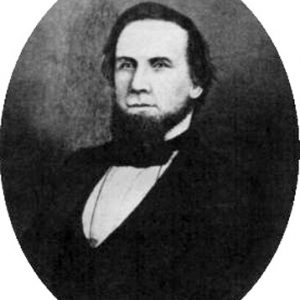calsfoundation@cals.org
Champagnolle (Union County)
Champagnolle, located on a bluff on the west bank of the Ouachita River, was an important early 1800s shipping point and social center of southern Arkansas. At its peak in the 1850s, thousands of bales of cotton were shipped yearly as far away as New Orleans, Louisiana. Bypassed by the railroad in the 1890s, the town began a slow decline. Little of the once prosperous settlement survives.
The first white settlers to the area were Lawrence, John, and Silas Scarborough, who were attracted by the potential of the river and the availability of potable water. Lawrence Scarborough built a home there and, in 1829, established Scarborough Landing on the river bank below a bluff. Others came, and soon a settlement began to develop on the bluff above the landing. William Young, who led a group of 900 Native Americans from Alabama to the Red River in 1830, became an important resident. In 1838, he was chosen as a commissioner to select a new county seat. That same year, A. G. Hill and C. F. Sargent formed a partnership and opened the settlement’s first mercantile.
Major growth came with the creation of Ouachita County from part of Union County in the late 1830s. Even before the creation of the new county in 1842, it was decided that, with the division of the land, a new, more centrally located Union County seat was needed. In 1839, commissioners, including resident William Young, decided upon Scarborough Landing. Albert Rust, who later became a U.S. congressman and Confederate general, supervised the surveying of the new county and established a storehouse under the bluff that was also used as the courthouse. A two-story jail was soon constructed under the supervision of Thomas Owen, and a weekly patrol of the county was conducted to reduce crime. Additional growth soon followed. Jarvis Langford opened a mercantile in 1841, followed by the Sparks Hotel established by William Town. It is believed to be the first in Union County. Mail service was available at the Union County Courthouse, the nearest post office. Confusion created by the name and additional growth along the river resulted in the establishment of a post office on May 6, 1846.
The name of the town was changed to Champagnolle about the same time that Ouachita County was being created. At least three stories survive concerning the origin. Some people claim that it was named after a Frenchman who was a close friend of Albert Rust. Or perhaps the name comes from a small area stream that was named by a French hunting party in 1805. Others say it was named after Pedro Champagnolle, a hunter/trader engaged in illegal trade with area Indians in the late 1700s. The Hunter-Dunbar Expedition recorded the name Cote de Champagnolle near the future town site in 1804.
In 1843, a petition to elect commissioners to examine the possibility of moving the county seat was circulated. Three commissioners were selected, and the seat was moved to El Dorado (Union County), nearer the center of the county in 1844. The loss of the seat of government seems to have had minimal negative effect on the town. On February 20, 1845, the federal government established a United States Land Office, making the town the center of the Champagnolle Land District. Hiram Smith was the first registrar. River traffic was booming by the 1850s, and the town began to experience expansion along the river. Development to the southwest was known as Dixonville and to the northwest as Warsaw.
The turmoil surrounding the secession crisis and the outbreak of the Civil War in 1861 was devastating to the river port town. Many of the young men enlisted in the Confederate military and marched off to war. Shipping on the river almost came to a standstill during the duration of the war, and many of the town’s businesses ceased to operate. In 1865, the government land office was moved to Washington (Hempstead County), the temporary state Confederate capital. The next year, the post office was also closed, reopening only in 1870.
With the end of the war, the town began a slow economic recovery. By the 1880s, much of the cotton market had returned, and the town was described as “a settlement of independent landowners” shipping thousands of bales of cotton each year. The population numbered about 100, with several stores and businesses. Prosperity was short lived, and an economic decline had begun by the 1890s. Much of this downturn was due to the decline of the importance of river traffic and the railroad grew more significant following the war. The railroad came to Union County in 1891, bypassing Champagnolle. Within a few years, the businesses closed, and all that remained were a few homes.
Renewed interest in the old town site came with the discovery of an area oil pool on June 22, 1927. Several wells in what was later called the Rainbow Bend Pool proved unproductive. In 1937, the Lion Oil Company purchased the old town site, laying a pipeline connecting to one of their local refineries and also constructing a loading rack and storage facility on the river. The facility remained in operation for only a short period of time.
In 1937, under the direction of the Daughters of the American Revolution and Lion Oil Company, a monument was erected commemorating the early Arkansas town. The monument, which is one of the town’s few physical reminders, was constructed using stones from the former land office.
For additional information:
Beaird, Bobby. “Champagnolle, Arkansas.” Tracks and Traces 6 (November 1984): 19–20.
Cordell, Anna H. “Champagnolle: A Pioneer River Town.” Arkansas Historical Quarterly 10 (Spring 1951): 37–45.
———. “Champagnolle: A Pioneer River Town.” Tracks and Traces 4 (June 1982): 1–7.
Yarbrough, Anna N. “Champagnolle, the Rascal, Had Town Named After Him.” Arkansas Democrat Magazine. July 19, 1953, p. 4.
Mike Polston
CALS Encyclopedia of Arkansas
 Albert Rust
Albert Rust  Union County Map
Union County Map 



Comments
No comments on this entry yet.